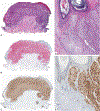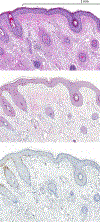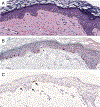PRAME Expression in Melanocytic Tumors
- PMID: 30045064
- PMCID: PMC6631376
- DOI: 10.1097/PAS.0000000000001134
PRAME Expression in Melanocytic Tumors
Abstract
PRAME (PReferentially expressed Antigen in MElanoma) is a melanoma-associated antigen that was isolated by autologous T cells in a melanoma patient. While frequent PRAME mRNA expression is well documented in cutaneous and ocular melanomas, little is known about PRAME protein expression in melanocytic tumors. In this study we examined the immunohistochemical expression of PRAME in 400 melanocytic tumors, including 155 primary and 100 metastatic melanomas, and 145 melanocytic nevi. Diffuse nuclear immunoreactivity for PRAME was found in 87% of metastatic and 83.2% of primary melanomas. Among melanoma subtypes, PRAME was diffusely expressed in 94.4% of acral melanomas, 92.5% of superficial spreading melanomas, 90% of nodular melanomas, 88.6% of lentigo maligna melanomas, and 35% of desmoplastic melanomas. When in situ and nondesmoplastic invasive melanoma components were present, PRAME expression was seen in both. Of the 140 cutaneous melanocytic nevi, 86.4% were completely negative for PRAME. Immunoreactivity for PRAME was seen, albeit usually only in a minor subpopulation of lesional melanocytes, in 13.6% of cutaneous nevi, including dysplastic nevi, common acquired nevi, traumatized/recurrent nevi, and Spitz nevi. Rare isolated junctional melanocytes with immunoreactivity for PRAME were also seen in solar lentigines and benign nonlesional skin. Our results suggest that immunohistochemical analysis for PRAME expression may be useful for diagnostic purposes to support a suspected diagnosis of melanoma. It may also be valuable for margin assessment of a known PRAME-positive melanoma, but its expression in nevi, solar lentigines, and benign nonlesional skin can represent a pitfall and merits further investigations to better assess the potential clinical utility of this marker.
Figures








References
-
- Ikeda H, Lethe B, Lehmann F, et al. Characterization of an antigen that is recognized on a melanoma showing partial HLA loss by CTL expressing an NK inhibitory receptor. Immunity. 1997;6:199–208. - PubMed
-
- Iura K, Maekawa A, Kohashi K, et al. Cancer-testis antigen expression in synovial sarcoma: NY-ESO-1, PRAME, MAGEA4, and MAGEA1. Hum Pathol. 2017;61:130–139. - PubMed
-
- Neumann E, Engelsberg A, Decker J, et al. Heterogeneous expression of the tumor-associated antigens RAGE-1, PRAME, and glycoprotein 75 in human renal cell carcinoma: candidates for T-cell-based immunotherapies? Cancer Res. 1998;58:4090–4095. - PubMed
Publication types
MeSH terms
Substances
Grants and funding
LinkOut - more resources
Full Text Sources
Other Literature Sources
Medical

